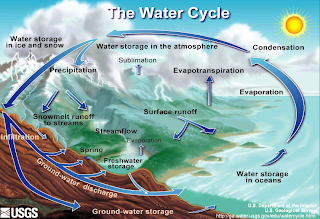The water cycle, also known as the hydrologic cycle or H2O cycle, describes the continuous movement of water on, above and below the surface of the Earth. Water can change states among liquid, vapor, and ice at various places in the water cycle. Although the balance of water on Earth remains fairly constant over time, individual water molecules can come and go. The water moves from one reservoir to another, such as from river to ocean, or from the ocean to the atmosphere, by the physical processes of evaporation, condensation, precipitation, infiltration, runoff, and subsurface flow. In so doing, the water goes through different phases: liquid, solid, and gas.
The hydrologic cycle also involves the exchange of heat energy, which leads to temperature changes. For instance, in the process of evaporation, water takes up energy from the surroundings and cools the environment. Conversely, in the process of condensation, water releases energy to its surroundings, warming the environment.
The water cycle figures significantly in the maintenance of life and ecosystems on Earth. Even as water in each reservoir plays an important role, the water cycle brings added significance to the presence of water on our planet. By transferring water from one reservoir to another, the water cycle purifies water, replenishes the land with freshwater, and transports minerals to different parts of the globe. It is also involved in reshaping the geological features of the Earth, through such processes as erosion and sedimentation. In addition, as the water cycle involves heat exchange, it exerts an influence on climate as well.
Different Processes
- Precipitation
- Condensed water vapor that falls to the Earth's surface . Most precipitation occurs as rain, but also includes snow, hail, fog drip, graupel, and sleet. Approximately 505,000 km3 (121,000 cu mi) of water fall as precipitation each year, 398,000 km3 (95,000 cu mi) of it over the oceans.
- Canopy interception
- The precipitation that is intercepted by plant foliage and eventually evaporates back to the atmosphere rather than falling to the ground.
- Snowmelt
- The runoff produced by melting snow.
- Runoff
- The variety of ways by which water moves across the land. This includes both surface runoff and channel runoff. As it flows, the water may seep into the ground, evaporate into the air, become stored in lakes or reservoirs, or be extracted for agricultural or other human uses.
- Infiltration
- The flow of water from the ground surface into the ground. Once infiltrated, the water becomes soil or groundwater.
- Subsurface Flow
- The flow of water underground, in the vadose zone and aquifers. Subsurface water may return to the surface (e.g. as a spring or by being pumped) or eventually seep into the oceans. Water returns to the land surface at lower elevation than where it infiltrated, under the force of gravity or gravity induced pressures. Groundwater tends to move slowly, and is replenished slowly, so it can remain in aquifers for thousands of years.
- Evaporation
- The transformation of water from liquid to gas phases as it moves from the ground or bodies of water into the overlying atmosphere. The source of energy for evaporation is primarily solar radiation. Evaporation often implicitly includes transpiration from plants, though together they are specifically referred to as evapotranspiration. Total annual evapotranspiration amounts to approximately 505,000 km3 (121,000 cu mi) of water, 434,000 km3 (104,000 cu mi) of which evaporates from the oceans.
- Sublimation
- The state change directly from solid water (snow or ice) to water vapor.
- Advection
- The movement of water — in solid, liquid, or vapor states — through the atmosphere. Without advection, water that evaporated over the oceans could not precipitate over land.
- Condensation
- The transformation of water vapor to liquid water droplets in the air, creating clouds and fog.
- Transpiration
- The release of water vapor from plants and soil into the air. Water vapor is a gas that cannot be seen.
Effects on climate
The water cycle is powered from solar energy. 86% of the global evaporation occurs from the oceans, reducing their temperature by evaporative cooling. Without the cooling, the effect of evaporation on the greenhouse effect would lead to a much higher surface temperature of 67 °C (153 °F), and a warmer planet.
Effects on biogeochemical cycling
While the water cycle is itself a biogeochemical cycle, flow of water over and beneath the Earth is a key component of the cycling of other biogeochemicals. Runoff is responsible for almost all of the transport oferoded sediment and phosphorus from land to waterbodies. The salinity of the oceans is derived from erosion and transport of dissolved salts from the land. Cultural euthropication of lakes is primarily due to phosphorus, applied in excess to agricultural fields in fertilizer, and then transported overland and down rivers. Both runoff and groundwater flow play significant roles in transporting nitrogen from the land to waterbodies. The dead zone at the outlet of the Mississippi River is a consequence of nitrates from fertilizer being carried off agricultural fields and funnelled down the river system to the Gulf of Mexico. Runoff also plays a part in the carbon cycle, again through the transport of eroded rock and soil.

Hi,
ReplyDeleteTry to understand the water cycle so that you can get something about the difficulties face by water before you get it. So filtration is most important for it. Thanks a lot.
Green Water Treatment